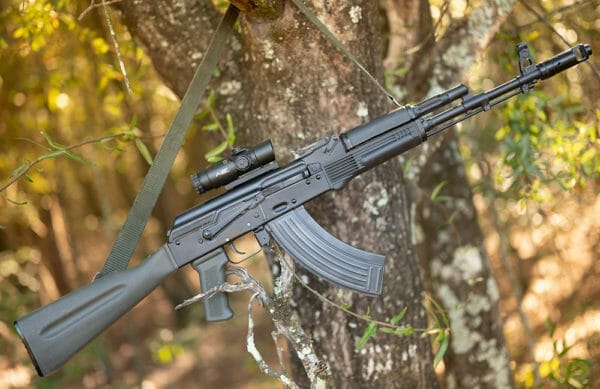Is Steel-Cased Ammunition Really All That Bad? ~ VIDEO
Forum Information
You will earn 1.5 pts. per new post (reply) in this forum.
**Registered members may reply to any topic in this forum**
You will earn 1.5 pts. per new post (reply) in this forum.
**Registered members may reply to any topic in this forum**
-
NHGF [Feed]

- Posts: 17274
- Joined: Mon Oct 30, 2017 5:16 pm
- Contact:
- Status: Offline
https://www.youtube.com/embed/is0Qyd_q4E0
U.S.A. -(AmmoLand.com)- COVID 19 and Joe Biden suck, they have driven the price of ammo through the roof, even previously-affordable steel-cased stuff. This is a huge problem given the recent surge in new gun-owners who are looking to hone their skills on their new guns, but simply can’t. They either can’t afford the rounds or can’t find the rounds at all – and whenever they can, the majority of the rounds are steel-cased. These rounds are often maligned for performance, reliability, and being generally inferior to brass-cased ammo. But are they really? Let’s take a closer look. Steel-Cased Ammo As its name suggests, steel-cased ammo utilizes steel for its shell casings instead of brass (or in the case of older Soviet ammo, bi-metal). Americans first got a taste for steel-cased rounds when China began exporting its arms and ammo to the US in the 1980s. With a price tag well below the average cost of American-made brass-cased ammo, many American shooters on a budget gobbled up the ammo in droves. But shortly thereafter, many found that the rounds weren’t performing as accurately, or reliably in their American firearms. The same held true a few years later when Russian Saigas, Mosin Nagants, and SKS carbines hit the market -but not for those guns. Many shooters began to see the value of steel-cased ammo when $299 Saiga carbines were able to chew through the stuff without a single hiccup. It may not have been match-grade or the cleanliest ammo, but the Soviet calibers ran perfectly in Soviet-designed firearms. Reliability What about American guns? Well, it depended on the action and type more than anything. The direct-impingement AR-15 can be ammo sensitive especially when not ran, ‘wet’. This was even more the case a few years ago when most companies made sure their guns were precisely gassed.
 Soviet-pattern firearms like this Russian-made Arsenal SGL-21 eat up steel-cased ammo with no problems. IMG Jim GrantIn a world where all ammo is accurately loaded, finely-tuned gas systems are ideal, the gun has less felt recoil, lasts longer, and requires less cleaning. But many companies around the mid-2000s discovered that customers were complaining that their guns weren’t reliable because they wouldn’t run Russian steel-cased ammo very well. The solution was simple – they over-gassed their guns. This is true of PSA, SIG, Anderson, Colt, and basically everyone today. But don’t get me wrong, they aren’t over-gassed to the point of negatively impacting performance. The guns are just slightly over-gassed to ensure reliable operation with underpowered cheap ammo. Bottom line: most modern firearms will have no issues whatsoever running with steel-cased ammo, but I would still recommend thorough lubrication and regular cleaning. Pros vs Cons Why would shooters pick steel-cased rounds over standard ammo? Price. That’s it. That’s the only real advantage of the ammo. As far as downsides, there are a few objective drawbacks to running steel and a few man-made ones. While the steel used in the ammo’s casings is relatively mild, and thus not terribly hard, it is still harder than brass. This means any component it comes in contact with will wear faster than if a shooter was running brass-cased rounds. The other real downside is that steel’s coefficient of friction is greater than that of brass, so when the spent casing is being extracted from a hot chamber, it requires more force to break the initial bond.
Soviet-pattern firearms like this Russian-made Arsenal SGL-21 eat up steel-cased ammo with no problems. IMG Jim GrantIn a world where all ammo is accurately loaded, finely-tuned gas systems are ideal, the gun has less felt recoil, lasts longer, and requires less cleaning. But many companies around the mid-2000s discovered that customers were complaining that their guns weren’t reliable because they wouldn’t run Russian steel-cased ammo very well. The solution was simple – they over-gassed their guns. This is true of PSA, SIG, Anderson, Colt, and basically everyone today. But don’t get me wrong, they aren’t over-gassed to the point of negatively impacting performance. The guns are just slightly over-gassed to ensure reliable operation with underpowered cheap ammo. Bottom line: most modern firearms will have no issues whatsoever running with steel-cased ammo, but I would still recommend thorough lubrication and regular cleaning. Pros vs Cons Why would shooters pick steel-cased rounds over standard ammo? Price. That’s it. That’s the only real advantage of the ammo. As far as downsides, there are a few objective drawbacks to running steel and a few man-made ones. While the steel used in the ammo’s casings is relatively mild, and thus not terribly hard, it is still harder than brass. This means any component it comes in contact with will wear faster than if a shooter was running brass-cased rounds. The other real downside is that steel’s coefficient of friction is greater than that of brass, so when the spent casing is being extracted from a hot chamber, it requires more force to break the initial bond.  The author with his Arsenal SLR-107UR Bulgarian AKM blasting through some steel-cased ammo. IMG Jim GrantThis in turn means more force is exerted on your firearm’s extractor which can lead to premature breakages if the gun wasn’t designed for the rounds in the first place. (SKS / AK owners, needn’t worry.) As far as man-made issues, many ranges ban the use of steel-cased ammo out of concern for their backstops – this is particularly true with indoor ranges. This is because most steel-cased ammo uses a mild steel core, and is difficult for ranges to differentiate from armor-piercing steel-core ammo which would quickly destroy targets. The other manufactured downside is that some companies will tell shooters that using steel-cased ammo voids their warranty. In my not-so-humble-opinion, this is a cop-out to let companies brush off shooters who want to run cheap ammo in their gun. Overall In a nutshell, steel-cased ammo is good to go. It’s not as powerful, clean, or pretty as brass-cased stuff, but it runs fine if your gun is properly-gassed. Just make sure to check your gun’s warranty before running it, just in case. About Jim Grant Jim is one of the elite editors for AmmoLand.com, who in addition to his mastery of prose, can wield a camera with expert finesse. He loves anything and everything guns but holds firearms from the Cold War in a special place in his heart. When he’s not reviewing guns or shooting for fun and competition, Jim can be found hiking and hunting with his wife Kimberly, and their dog Peanut in the South Carolina low country.
The author with his Arsenal SLR-107UR Bulgarian AKM blasting through some steel-cased ammo. IMG Jim GrantThis in turn means more force is exerted on your firearm’s extractor which can lead to premature breakages if the gun wasn’t designed for the rounds in the first place. (SKS / AK owners, needn’t worry.) As far as man-made issues, many ranges ban the use of steel-cased ammo out of concern for their backstops – this is particularly true with indoor ranges. This is because most steel-cased ammo uses a mild steel core, and is difficult for ranges to differentiate from armor-piercing steel-core ammo which would quickly destroy targets. The other manufactured downside is that some companies will tell shooters that using steel-cased ammo voids their warranty. In my not-so-humble-opinion, this is a cop-out to let companies brush off shooters who want to run cheap ammo in their gun. Overall In a nutshell, steel-cased ammo is good to go. It’s not as powerful, clean, or pretty as brass-cased stuff, but it runs fine if your gun is properly-gassed. Just make sure to check your gun’s warranty before running it, just in case. About Jim Grant Jim is one of the elite editors for AmmoLand.com, who in addition to his mastery of prose, can wield a camera with expert finesse. He loves anything and everything guns but holds firearms from the Cold War in a special place in his heart. When he’s not reviewing guns or shooting for fun and competition, Jim can be found hiking and hunting with his wife Kimberly, and their dog Peanut in the South Carolina low country. 